Showing top 0 results 0 results found
Showing top 0 results 0 results found
All You Need to Know to Use Chatbots in Business. Complete Guide 2025

Since 2016, when Facebook opened Messenger to chatbots, companies have been exploring their potential. Chatbots have become a core part of customer service, marketing, and sales strategies. With advancements in artificial intelligence (AI) — especially generative models like ChatGPT — chatbots are now smarter, more conversational, and capable of handling complex interactions.
The global chatbot market is projected to reach approximately $10.32 billion in 2025, reflecting a compound annual growth rate (CAGR) of 24.8% from the previous year. But what exactly are chatbots, and why have they become so valuable?
This guide breaks it all down — what chatbots are, how they work, and why they're a must-have for modern businesses. Whether you want to improve customer communication and support, boost engagement, or increase sales, you'll learn how chatbots can fit into your strategy.
👉 What is a chatbot?
👉 How do chatbots work?
👉 The brief history of chatbots
👉 How to create a chatbot
👉 Why do businesses need chatbots?
👉 Chatbot use cases
What is a chatbot?
A chatbot is an AI-powered software application designed to simulate human conversations through text or voice interactions. It uses AI, machine learning (ML), natural language processing (NLP), and natural language understanding (NLU) to understand user queries, interpret user inputs, and deliver relevant, conversational responses in real time.
Where can you use chatbots?
Modern AI chatbots integrate seamlessly with websites, live chat tools, and messaging platforms like Facebook Messenger, WhatsApp, or Slack. Chatbots are available across multiple channels, enabling automated interactions on platforms that customers already use and improving convenience and accessibility.
💡 Fact: Chatbots exist under many names: conversational agents, AI assistants, chatterbots, conversational interfaces, virtual agents, digital assistants, automated responders, or AI-powered chat assistants.
How do chatbots work?
Chatbots operate using either predefined rules or advanced AI technologies. Depending on their underlying mechanism, they process human input (user queries), interpret intent, and deliver appropriate responses. Businesses typically leverage three main types of chatbots, each designed to match different operational needs:
- Rule-based chatbots
- AI chatbots
- Hybrid chatbots
Rule-based chatbots
A rule-based chatbot (also command-based, keyword, transactional, or pattern matchers) communicates using predefined answers.
These virtual assistants can be playfully compared to movie actors because they always stick to the script. They provide answers based on a set of if/then rules that can vary in complexity. These rules are defined in the chatbot implementation process.
It's worth adding that rule-based chatbots don't understand the context of the conversation. They provide matching answers only when users use a keyword or a phrase they were programmed to answer.
When a rule-based bot is asked, “How can I reset my password?” it first looks for familiar keywords in the sentence. In this example, “reset” and “password” are the keywords. Then, it matches these keywords with responses available in its database to provide the answer.
However, if anything outside the rule-based chatbot's scope is presented, like a different spelling or dialect, it might fail to match that question with an answer. Because of this, rule-based bots often ask users to rephrase their questions.
It's worth underlining that a rule-based chat interface can't learn from past experiences. They respond based on what they know at that moment. The only way to improve a rule-based bot for future interactions is to equip it with more predefined answers and improve its rule-based mechanisms.
While rule-based bots are still widely used, many businesses are enhancing them with AI to provide better, more flexible responses and better user entity recognition.
AI chatbots
An AI chatbot is software that interacts with users in a human-like manner and can imitate natural human language. Unlike rule-based bots, AI chatbots use ML algorithms, NLP, and deep learning to understand context, predict user needs, and generate unique, context-aware responses.
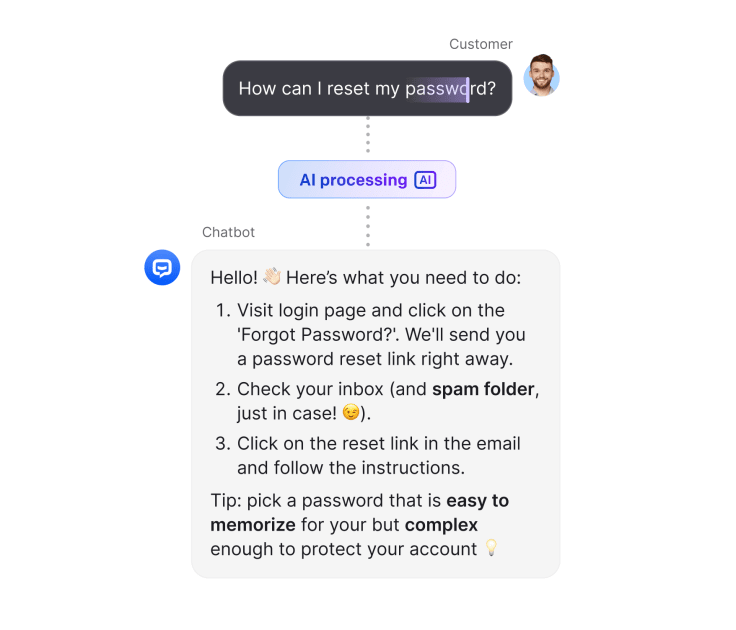
- AI empowers computers to perform tasks requiring human-like reasoning, such as understanding language, managing conversations, making decisions, and learning from interactions. AI integrates fields like computer science, data analysis, speech recognition, hardware engineering, language translation, linguistics, neuroscience, philosophy, psychology, and software engineering, continuously evolving through advancements in deep learning and generative models.
- ML allows AI chatbots to identify patterns, make decisions, and improve from past and real-time interactions. Large language models (LLMs), trained on vast datasets, dynamically refine responses based on new inputs. Unlike rule-based chatbots, AI chatbots use machine learning algorithms to enhance accuracy, generate relevant responses, and adjust tone or style in real time, and that enables personalized recommendations, advanced troubleshooting, and natural conversations.
- NLP makes AI chatbots understand, interpret, and generate human-like conversations. Context-aware AI in 2025 has advanced NLP, allowing chatbots to remember interactions and provide personalized experiences. Whether in customer support, ecommerce, or healthcare, AI chatbots now recognize intent, grasp context despite errors or slang, and deliver seamless responses across conversations, ensuring real-time personalization and engaging user interactions.
- Sentiment analysis lets AI chatbots gauge user emotions in real time. By analyzing text, voice tone, emojis, and speech patterns, chatbots can determine if a user is frustrated, satisfied, or neutral and adjust their responses accordingly. Emotion-aware AI enhances sentiment analysis by enabling chatbots to modify tone, suggest empathetic solutions, or escalate issues when necessary.
💡 Fact: Some languages are more difficult for chatbots to process. Languages such as Polish, Finnish, Spanish, or Hindi, whose verbs may present a wide range of variations, are more difficult for a chatbot to master than languages with less complex structures.
Hybrid chatbots
Interacting with chatbots used to feel like talking to an answering machine — repetitive, robotic, and frustrating. If a customer didn’t phrase their question exactly right, they’d get the familiar and unhelpful response: “I’m sorry, I don’t understand.”
Then came AI chatbots, which seemed like the solution to everything. They could generate fluid, human-like conversations, offering quick and engaging responses. But these AI-driven bots had their flaws. They sometimes misunderstood key details, provided inaccurate answers, or worse — invented information when they didn't know the answer.
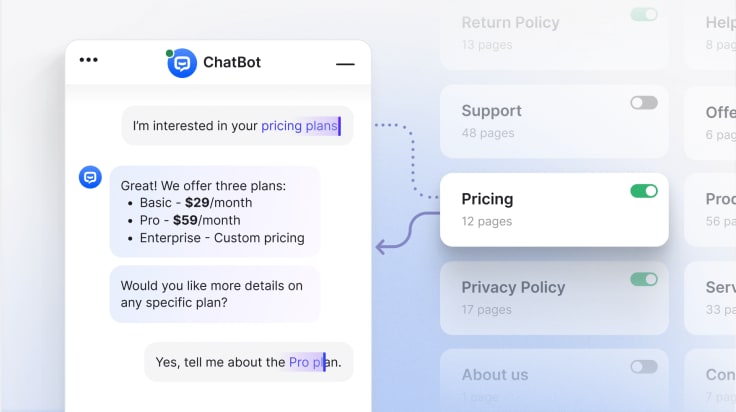
Faced with these challenges, many businesses realized they needed a middle ground — a chatbot that could offer AI-powered flexibility while maintaining structured reliability. This is where hybrid chatbots emerged as the gold standard. Here's how hybrid chatbots improve key areas of customer service:
- Keeping brand messaging on point: Accuracy is crucial in regulated industries like finance, healthcare, and insurance. AI chatbots can simplify complex topics, but errors in rates or policies erode trust. A hybrid model — AI for general inquiries and rule-based responses for sensitive details — enhances reliability. This approach makes chatbots both smarter and more trustworthy.
- Preventing AI from guessing when it doesn't know: AI chatbots sometimes generate answers even when unsure, leading to misinformation. A hybrid model prevents this by redirecting users to verified resources, escalating complex queries to human agents, or relying on rule-based fallback responses. This approach ensures accuracy while maintaining seamless interactions.
- Smarter escalation to human agents: Customers often get stuck in chatbot loops, receiving repetitive responses instead of real assistance. A hybrid model solves this by handling routine inquiries while recognizing when a request requires human support. By seamlessly transitioning complex cases to live agents, businesses improve efficiency, reduce frustration, and enhance customer satisfaction.
- Balancing personalization without crossing the line: AI chatbots enhance customer experience with tailored recommendations, but excessive tracking can feel intrusive. A hybrid approach ensures balance by using AI for relevant suggestions while applying structured data controls to respect privacy. This way, chatbots stay helpful without overstepping boundaries.
- Cost savings without sacrificing quality and customer satisfaction: Chatbots help businesses cut costs, but fully AI-driven models can frustrate customers. A hybrid approach balances automation and human support by handling routine inquiries, using rule-based responses for accuracy, and escalating only when necessary. This improves efficiency, reduces costs, and ensures high-quality customer service.
Hybrid chatbots combine AI efficiency with structured safeguards to ensure accuracy. They use automation for speed but involve human support when needed. As a result, customer satisfaction rises, personalization respects privacy, and costs go down—making customer service more reliable and effective.
Rule-based chatbots, AI chatbots, and hybrid chatbots comparison
| How they work | Business benefits | Limitations | |
| Rule-based chatbots |
- Operate on an if-then logic (for instance, if a user types “reset password,” the bot provides password reset steps) - Require manual updates to expand their responses |
- Cost-effective and quick to deploy - Ensure consistent responses - Work well for structured processes |
- Struggle with complex queries and require exact keywords to function properly - Can't learn from interactions - Often need to escalate queries to live agents for complex issues |
| AI chatbots |
- Use machine learning and natural language processing to understand user intent and generate dynamic responses - Can analyze past interactions and improve over time without manual updates |
- Handle complex, open-ended conversations effectively - Learn from interactions to enhance accuracy and personalization - Scale customer support by automating a high volume of queries |
- Require high-quality training data and continuous refinement - Can generate inaccurate or unexpected responses if not properly trained |
| Hybrid chatbots |
- Combine rule-based logic with AI to provide structured yet flexible interactions - Use predefined workflows while leveraging AI to handle more complex or unexpected queries |
- Balance automation with human-like adaptability - Provide reliable responses while allowing AI to manage nuanced conversations - Reduces escalation to live agents by handling a wider range of queries |
- Require initial setup to align AI and rule-based workflows - Need a structured knowledge base or historical data to effectively train AI and ensure accurate responses |
The brief history of chatbots
Conversational interfaces aren't a modern invention. They were born out of curiosity and creative thinking over half a century ago.
1950: Alan Turing — the man who started it all
Alan Turing, often hailed as the pioneer of computer science and artificial intelligence, made groundbreaking contributions that laid the foundation for modern AI and chatbots. Turing proposed the Turing Test, a measure designed to evaluate a machine's ability to exhibit intelligent behavior indistinguishable from a human's. This test involves a human judge engaging in a conversation with both a human and a machine without knowing which is which. If the judge cannot reliably distinguish the machine from the human, the machine is considered to have passed the test.
Turing's visionary work in artificial intelligence had a profound impact on the development of chatbots and other AI-powered systems.
1966: Eliza — the first chatbot
MIT professor Joseph Weizenbaum developed Eliza, one of the first programs to simulate human-like conversation. Often considered the first chatbot, Eliza used pattern matching and scripted responses to mimic a Rogerian psychotherapist. It did not understand the language but could create the illusion of conversation by reflecting users' statements. For example, if a user said, “My mother loves flowers,” Eliza might respond, “Tell me more about your mother.”
1971: Parry
Kenneth Colby, a Stanford Artificial Intelligence Laboratory psychiatrist, wondered if computers could contribute to understanding brain function. He believed that computers could help treat patients with mental diseases.
These thoughts led Colby to develop Parry, a computer program that simulated a person with schizophrenia. Colby believed that Parry could help educate medical students before they started treating patients. Parry was tested against human psychiatrists, who often struggled to distinguish it from real patients. Its creation initiated a serious debate about the possibilities of artificial intelligence at the time.
💡 Fact: In 1978, Colby developed the first intelligent speech prosthesis, a computer program that helped people with communication disorders speak.
1988: Jabberwacky
Self-taught programmer Rollo Carpenter began developing Jabberwacky, a chatbot designed for entertaining, human-like conversation. Unlike rule-based programs, Jabberwacky learned from past interactions, improving its responses over time. Though it did not truly "understand" users, it created the illusion of personality by mimicking previous conversations. Its development laid the groundwork for Cleverbot, a more advanced AI-powered chatbot released in the 2000s.
1992: Dr. Sbaitso
Creative Labs, a technology company based in Singapore, developed Dr. Sbaitso. It was an AI speech synthesis program that imitated a psychologist. The program was distributed with sound cards sold by the company. They wanted to show the digitized voices their cards were able to produce.
1995: A.L.I.C.E.
Richard Wallace developed Artificial Linguistic Internet Computer Entity (A.L.I.C.E.), an advanced chatbot designed to simulate natural conversation. Inspired by Eliza, A.L.I.C.E. used pattern matching and heuristic rules to generate responses. Unlike earlier chatbots, it relied on Artificial Intelligence Markup Language (AIML), allowing more dynamic conversations.
Wallace released A.L.I.C.E.’s code as open source, enabling other developers to create their own conversational AI. The chatbot influenced many later AI systems, shaping the development of modern virtual assistants.
Fun fact: Alice was an inspiration for an American science-fiction romantic drama Her, a film about a man who falls in love with a chatbot.
2001: SmarterChild
SmarterChild was an intelligent chat interface built on AOL Instant Messenger by ActiveBuddy, a brand that creates conversational interfaces. It was designed to have a natural conversation with users. SmarterChild is considered a precursor to Apple's Siri.
2010: Virtual assistants
Since 2010, when Apple launched Siri, virtual assistants have been on the rise. Siri was the first personal assistant available worldwide. Google followed in Apple's footsteps by releasing Google Now in 2012. Microsoft's Cortana and Amazon's Alexa were both released in 2014.
2016: Chatbot platforms
Facebook opened its Messenger platform to chatbots, allowing businesses and developers to create automated conversational agents. This move fueled the rapid growth of chatbot technology, making automated customer support and interactive messaging more accessible.
By 2018, Messenger had over 300,000 active bots, assisting users with tasks like shopping, booking appointments, and customer service. Over the years, chatbot technology has advanced significantly, integrating AI and natural language processing for more sophisticated interactions.
2020: AI chatbots step up during a global crisis
As the world shut down due to the COVID-19 pandemic, AI chatbots became frontline responders. Healthcare organizations and governments scrambled to provide reliable information, and chatbots became an essential tool. The World Health Organization (WHO) launched its WhatsApp chatbot on March 20, 2020, instantly connecting people with accurate COVID-19 updates. Meanwhile, the UK’s National Health Service (NHS) introduced an AI-powered chatbot to help triage potential cases, easing the burden on overwhelmed phone lines.
Beyond healthcare, businesses turned to AI chatbots for survival. With customer service teams working remotely or facing staff shortages, automated bots kept operations running. Banking apps rolled out AI assistants to handle increased queries about loan deferrals, while ecommerce platforms used chatbots to manage a surge in online shopping. This period marked the true beginning of chatbots as indispensable digital workers rather than just a novelty.
2022: Chatbots go viral with ChatGPT
Until 2022, AI chatbots were improving but still had their limitations. Then, on November 30, 2022, OpenAI released ChatGPT — and everything changed. Within five days, over a million users had signed up to test this groundbreaking conversational AI. ChatGPT wasn’t just another chatbot. It could write essays, debug code, explain complex topics, and even crack jokes with near-human fluency.
Tech companies immediately took notice. Microsoft quickly partnered with OpenAI, announcing in early 2023 that it would integrate ChatGPT into Bing, turning the aging search engine into an AI-powered assistant. Google, caught off guard, rushed to announce Bard in February 2023, marking the start of a fierce AI arms race.
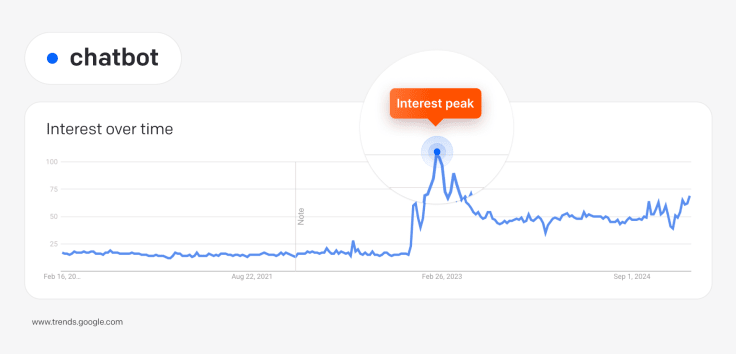
2023: AI chatbots become part of everyday life
By early 2023, chatbots weren’t just helping businesses — they were everywhere. People were using ChatGPT and similar models for everything from writing resumes to planning vacations. Companies that previously treated chatbots as optional tools were now building AI-powered customer experiences around them.
On March 14, 2023, OpenAI launched GPT-4, a more powerful and multimodal AI capable of understanding both text and images. This opened new possibilities — AI assistants could now analyze photos, generate visuals, and even interpret handwriting.
Meanwhile, Snapchat launched its AI chatbot, My AI, in April 2023, allowing users to chat with an AI as if it were a friend. In the finance sector, banks began rolling out AI-powered financial advisors to help customers with budgeting and investments. The chatbot boom was officially in full swing.
Yet, with this rapid adoption came concerns. Companies faced backlash when chatbots gave misleading or biased responses. AI hallucinations — when a chatbot confidently makes up incorrect information — became a hot topic. Businesses realized that while AI chatbots were powerful, they still needed human oversight and safeguards.
2024: AI chatbots become multimodal and smarter than ever
By January 2024, chatbots were no longer just text-based tools. The newest AI assistants could now process voice, images, and even generate videos, making interactions more natural and intuitive. Imagine snapping a photo of a broken appliance and having an AI chatbot diagnose the issue instantly — this was becoming a reality.
On February 8, 2024, Google launched Gemini, its next-generation AI model, which promised better reasoning and multimodal capabilities. Meanwhile, OpenAI introduced custom GPTs, allowing businesses and individuals to train AI chatbots for specific tasks without needing technical expertise. Suddenly, everyone from small business owners to educators could create their own personalized AI assistant.
Retailers embraced AI like never before. Amazon integrated AI into Alexa, making it more conversational and proactive in assisting users. In ecommerce, AI shopping assistants became a standard feature, helping customers find products, compare prices, and even generate outfit suggestions.
With multimodal capabilities and personalized AI assistants, chatbots were no longer just for answering questions. They were actively shaping how people worked, learned, and made decisions.
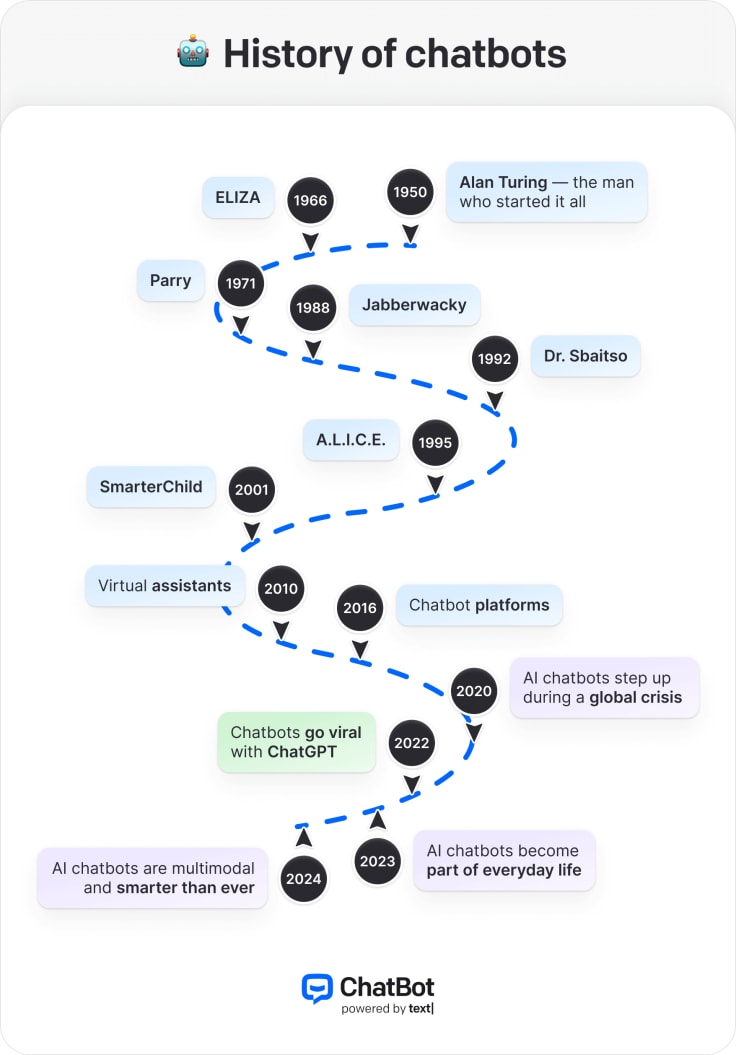
How to build a chatbot in 2025
Building a chatbot has never been easier with a range of no-code platforms, low-code frameworks, and custom AI solutions. Businesses can choose between quick and accessible chatbot platforms or fully customized AI-powered assistants depending on their needs, budget, and technical expertise.
Whether the goal is to automate customer service, marketing lead generation, or sales, advanced tools are available to create smarter AI-driven chatbots.
Using a chatbot platform for quick deployment
Using a chatbot platform remains the fastest and most efficient way to create and launch a chatbot. In 2025, chatbot platforms have evolved into AI-powered automation hubs with built-in drag-and-drop workflow builders, pre-trained AI templates, and seamless omnichannel integrations. These platforms are designed for businesses that need an AI assistant without investing in complex development.
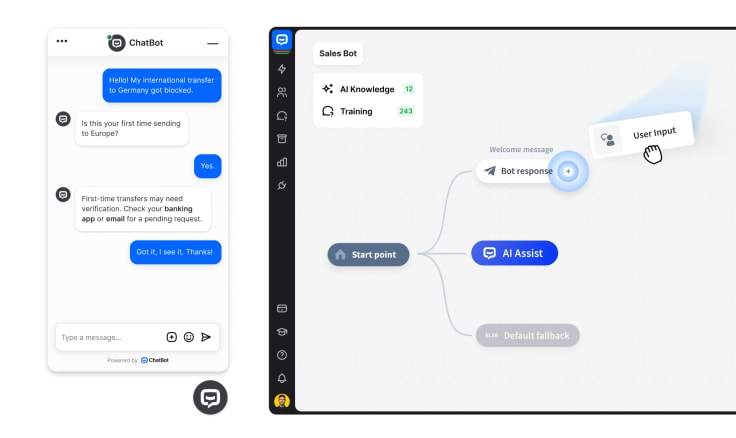
Why chatbot platforms are the best choice for many businesses
✔ No coding required – Create chatbots with simple drag-and-drop interfaces.
✔ Pre-built AI templates – Ready-to-use chatbots for customer service, ecommerce lead generation, and support.
✔ Omnichannel capabilities – Deploy chatbots on websites, Messenger, Slack and more,
✔ AI-powered NLP – Improve chatbot responses with generative AI.
✔ Integration with business tools – Connect with Salesforce, Zendesk, Shopify, HubSpot, and many others.
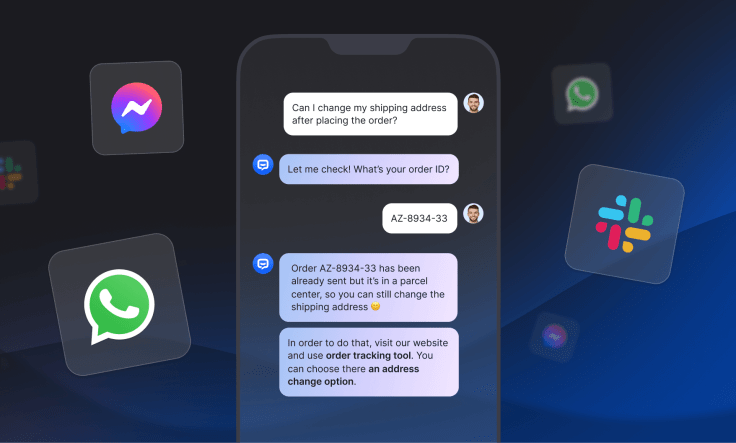
For businesses looking for fast, cost-effective, and scalable AI, chatbot platforms provide an easy entry point. They allow teams to deploy a working chatbot in minutes without needing technical expertise.
Chatbot platforms make business automation accessible. Many of them offer simple drag-and-drop builders. They allow for building and implementing chatbots with little or no coding. This helps to popularize chatbots among less technical users who get a chance to develop their own chatbot projects.
Kacper Wiącek, Product Experts Lead
Why ChatBot.com is the best chatbot platform in 2025
Among chatbot platforms, ChatBot.com stands out as the best option for businesses focusing on customer service, marketing, lead generation, and sales automation. It offers an intuitive interface that allows companies to create and launch AI-driven chatbots without requiring any coding experience, making it accessible to businesses of all sizes.
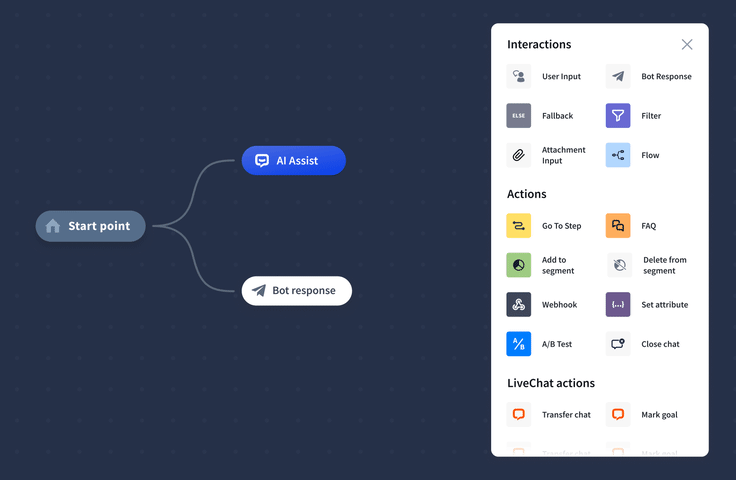
With powerful AI automation features, businesses can handle customer inquiries, generate leads, and drive sales while maintaining a natural and engaging interaction. ChatBot.com provides a variety of pre-built templates intelligent response mechanisms and seamless integration with multiple channels such as websites social media and messaging apps ensuring a smooth customer experience.
Unlike AI frameworks that demand extensive development and technical expertise, ChatBot.com simplifies the process, allowing businesses to implement and refine chatbot strategies quickly and without significant overhead.
Building a custom chatbot with AI frameworks and APIs
For businesses requiring AI assistants with deep integrations and advanced customization, developing a chatbot using AI frameworks and APIs offers flexibility and control. In 2025, creating a chatbot from scratch has become more accessible due to AI development tools that provide pre-trained models and scalable architectures.
Several AI frameworks and APIs support chatbot development, each catering to different needs. Some, like OpenAI’s GPT-4 and GPT-5 API, focus on conversational AI, enabling natural dialogue and contextual understanding.
Others, such as Google Gemini AI, specialize in multimodal capabilities, processing text, voice, and images. Enterprise solutions like Microsoft Azure AI Bot Services provide scalability and cloud integration, making them suitable for large-scale business applications.
These frameworks allow businesses to train AI assistants on proprietary data, ensuring seamless integration with internal systems and more tailored responses. Custom AI chatbots are particularly beneficial in industries like finance, healthcare, legal services, and enterprise automation, where security, accuracy, and compliance are essential.
Before committing to a fully custom chatbot, businesses should first experiment with platform-based solutions to define their chatbot’s key requirements. This allows companies to understand what works before investing in large-scale AI development.
Why do businesses need chatbots?
Technological progress has radically changed the way people communicate. Face-to-face interactions have been largely replaced by online messaging, forcing businesses to adapt to a new type of communication. To achieve success, brands need to provide a seamless buyer's journey and respond to customer questions around the clock and across multiple channels.
But living up to the rising expectations of “always-connected” customers is not the easiest and cheapest task. The more your business grows, the more it costs to deliver 24/7 customer service. This is where chatbots come in handy. They allow brands to scale up their support services at a low cost.
More and more often, companies are deciding to introduce bot applications into their marketing strategies because they allow for delivering personalized and consistent brand experiences. In the long term, that translates into better brand perception and more sales.
What tasks can be automated with chatbots?
The primary role of chatbot technology is to automate conversations and handle user interactions without human intervention. Chatbots are used to:
- Enhance customer service by providing instant, 24/7 responses.
- Reduce wait times and manage multiple inquiries simultaneously.
- Increase sales and lead generation through automated recommendations and personalized messaging.
- Boost engagement by interacting with customers on their preferred platforms.
Chatbot use cases
Chatbots in customer support
Customers want their problems immediately handled through the channels they prefer. Chatbots make that possible by redefining the customer service people have known for years.
They support customers 24/7 and enable them to solve simple problems, book appointments, or submit complaints. Customer service bots allow companies to scale their services at low cost but, more than that, meet changing customer expectations.
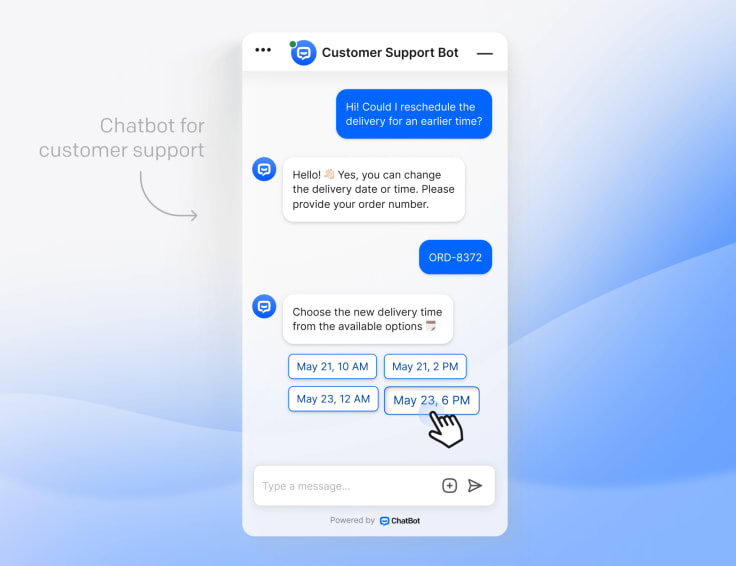
Take Mastercard, for instance. The brand offers a messenger bot to help customers easily check their account transactions anytime.
In the healthcare industry, Cleveland Clinic has introduced a chatbot to assist patients in finding doctors, scheduling appointments, and answering frequently asked questions about treatments. The bot helps reduce call center wait times and ensures patients get immediate assistance.
Similarly, Amtrak, the national rail service, uses a virtual assistant, Julie, to help passengers book train tickets and answer common travel inquiries. Since implementing Julie, Amtrak has significantly increased bookings and user satisfaction.
Chatbots in marketing
Brands use conversational agents to diversify their customer engagement strategy. With them, businesses engage website visitors proactively and, eventually, sell more products.
One of the brands that took their online service to the next level using a bot is Sephora. The company uses it to educate customers about its products. Their AI assistant offers makeup tutorials and skincare tips and helps customers purchase products online. The company even enables its customers to try new makeup using AR technology implemented in their chatbot. By doing this, Sephora has delivered its personalized customer experience in-store and online.
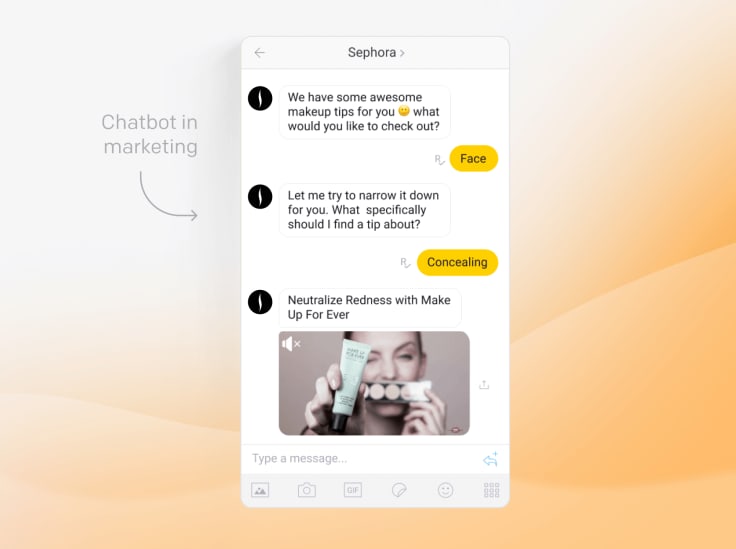
Another major player that uses chatbots effectively is Nike. To engage with customers, the brand launched a Messenger chatbot that recommends sneaker models based on user preferences and helps them purchase exclusive releases. The bot even allows users to design their own custom sneakers and share them with friends before buying, turning the shopping experience into an interactive journey.
Chatbots in sales
Every customer must go through the sales funnel before purchasing a product. Chatbots can take customers by hand and walk them through all the stages of that process: awareness, interest, decision, and action. Forbes notes that chatbots can deliver 67% higher sales conversion rates on average compared to traditional channels.
Conversational interfaces integrate into social media platforms, letting brands connect with many users and increase their brand awareness. Take, for example, National Geographic. The company has used a messenger bot to carry out a daily quiz with users. By doing this, the brand attracted users' attention to its new ebook, Almanac. The brand's bot also encouraged users to purchase the title by offering a 10% discount, which boosted its sales.
Global giant Starbucks uses an AI agent to help customers compose their favorite coffee drink. It enables customers to order a drink on the go and pick it up at a chosen café. It translates into a better brand experience because customers don't have to stand in a long line.
Retailers have also leveraged AI assistants to streamline shopping experiences. Walmart, for instance, introduced a voice-ordering chatbot integrated with Google Assistant, allowing customers to add items to their cart hands-free. This innovation makes grocery shopping easier and more convenient for busy customers.
Chatbots in ecommerce and retail
Ecommerce businesses are increasingly turning to AI chatbots to automate customer interactions and improve the shopping experience. With an AI-powered shopping assistant, brands can provide personalized recommendations, guide customers through purchasing, and even handle post-purchase inquiries.
Take H&M, for example. The fashion retailer launched a chatbot that helps customers find clothing items based on their style preferences. By asking users a few quick questions, the bot curates a selection of outfits that match their taste, making online shopping more engaging and interactive.
Similarly, Nordstrom has integrated AI chat technology to assist shoppers with product searches and availability. The chatbot helps customers navigate the retailer’s extensive catalog and even suggests complementary products, boosting cross-sell and upsell opportunities.
Retail giants like Amazon take this a step further. Their AI-powered voice assistant, Alexa, helps customers shop hands-free and provides order tracking, product recommendations, and even customer service support. This seamless integration between AI and retail allows brands to offer a more intuitive and personalized shopping experience.
Chatbots in healthcare
The healthcare industry has seen significant improvements in patient engagement and service efficiency through chatbots. They help clinics and hospitals manage appointment scheduling, medication reminders, and patient inquiries while reducing the workload on medical staff.
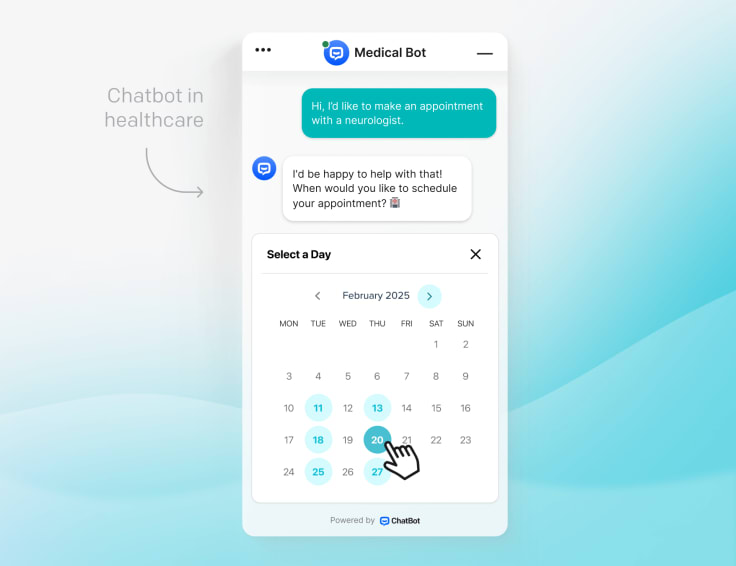
For instance, the Mayo Clinic developed a chatbot that provides reliable health information, answering common medical questions based on evidence-based research. This tool helps patients access important information without waiting for a doctor's appointment.
Even pharmacies are benefiting from AI assistants. CVS Health introduced a chatbot that helps customers refill prescriptions, check medication availability, and receive health advice. The chatbot makes it easier for customers to manage their prescriptions without visiting a store.
Chatbots in education and e-learning
AI chatbots are revolutionizing the education sector by assisting students with learning, answering questions, and even providing administrative support. Schools, universities, and online learning platforms are leveraging this technology to create a more interactive and personalized learning experience.
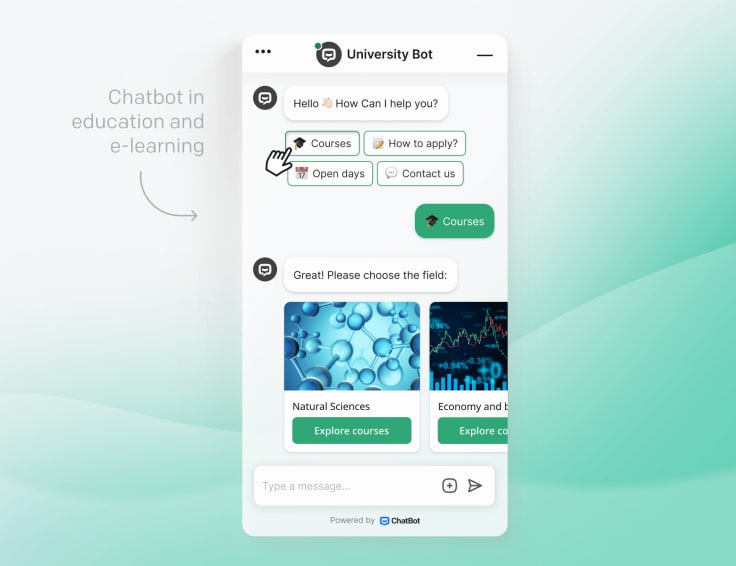
For example, Arizona State University implemented a chatbot to help students navigate admissions, enrollment, and financial aid. By answering frequently asked questions instantly, the chatbot helps students get the necessary information without long wait times.
Chatbots in finance and banking
Banks and financial institutions have embraced AI-driven chatbots to improve customer service, assist with transactions, and provide financial guidance. These bots help customers check their account balances, monitor spending habits, and even receive real-time fraud alerts.
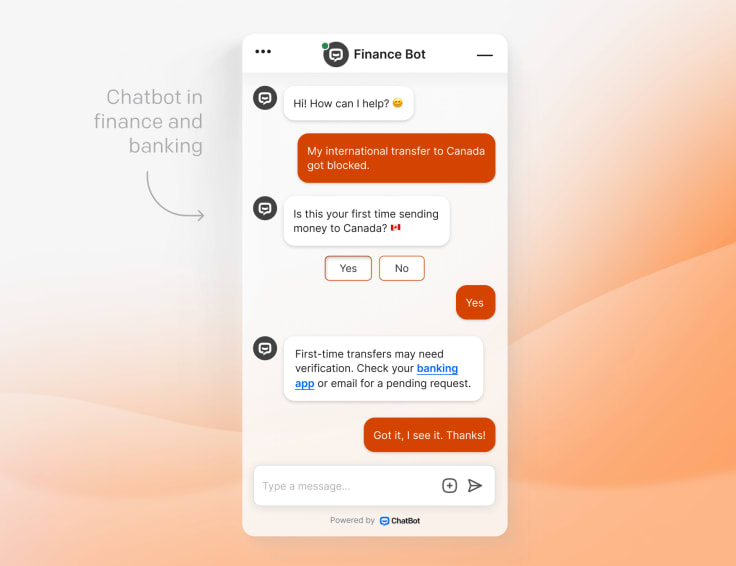
Take Bank of America, for instance. Their virtual assistant, Erica, helps customers manage their accounts, track spending, and receive personalized financial insights. With Erica, customers can make payments, lock debit cards, and get real-time updates on their financial health.
Another financial institution, Capital One, launched Eno, an AI-powered chatbot that helps customers track expenses and get notifications about unusual account activity. Eno proactively alerts users if it detects a suspicious transaction, adding an extra layer of security.
Similarly, PayPal uses a chatbot to assist users with transactions, refunds, and payment disputes. By providing instant support, PayPal ensures that its customers receive fast resolutions without contacting a human agent.
Chatbots in entertainment and media
The entertainment industry has also adopted chatbots to engage audiences and provide content recommendations. Streaming services, movie studios, and gaming companies use AI to enhance user experiences and boost content discovery.
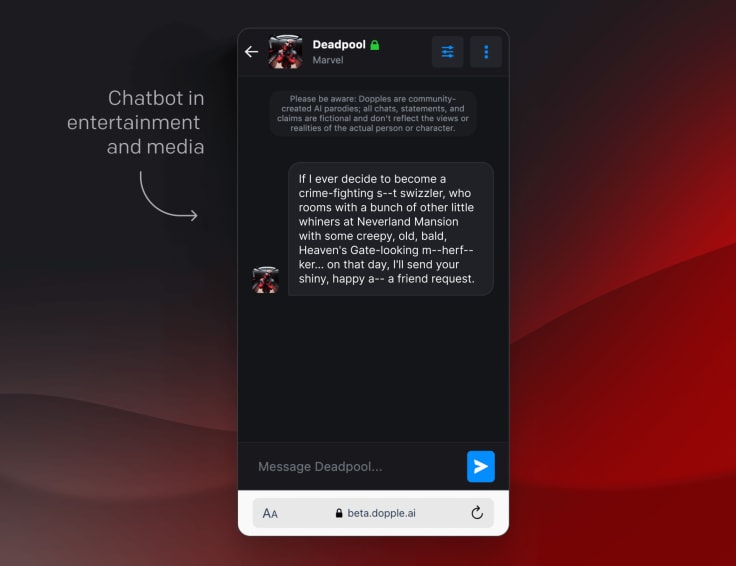
In the film industry, 20th Century Studios created a chatbot to promote their movie Deadpool 2. The bot engaged with fans through witty, character-driven conversations, generating excitement and increasing box office sales.
Travel and hospitality
The travel and hospitality industry has embraced AI chatbots to improve customer service, streamline booking processes, and enhance guest experiences. Hotels, airlines, and travel agencies use these tools to provide instant support and personalized travel recommendations.
For example, Hilton Hotels collaborated with IBM to develop a robot named Connie to assist guests with hotel services, local recommendations, and room bookings. The AI assistant provides real-time answers to guests’ questions, making their stay more enjoyable and hassle-free.
Meanwhile, Delta Airlines offers a concierge chatbot that helps passengers check flight status, change bookings, and get real-time updates on delays. By automating these tasks, the airline reduces call center wait times and improves customer satisfaction.
Summary
In 2025, AI-driven conversational interfaces have evolved beyond simple automation. They are not a replacement for human interactions yet, but they are becoming more and more seamlessly implemented in customer service operations. Their role is to enhance efficiency, automate workflows, and improve user experiences — allowing humans to focus on more meaningful and strategic tasks.



